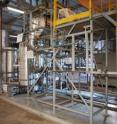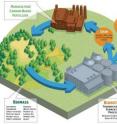Ancient soil replenishment technique helps in battle against global warming
Former inhabitants of the Amazon Basin enriched their fields with charred organic materials-biochar-and transformed one of the earth's most infertile soils into one of the most productive. These early conservationists disappeared 500 years ago, but centuries later, their soil is still rich in organic matter and nutrients. Now, scientists, environmental groups and policymakers forging the next world climate agreement see biochar not only as an important tool for replenishing soils, but as a powerful tool for combating global warming. Christoph Steiner, a University of Georgia research scientist in the Faculty of Engineering, was a major contributor to the biochar proposal that was submitted by the United Nations Convention to Combat Desertification last week at the United Nations Climate Change Conference meeting in Poland. The new climate change agreement will replace the Kyoto Protocol, which expires in 2012.
"The potential of biochar lies in its ability to sequester-capture and store-huge amounts of carbon while also displacing fossil fuel energy, effectively doubling its carbon impact," said Steiner, a soil scientist whose research in the Amazon Basin originally focused on the use of biochar as a soil amendment. At UGA's Biorefinery and Carbon Cycling Program, he now investigates the global potential of biochar to sequester carbon. He also serves as a consultant to the UNCCD, a sister program to the climate change convention.
Steiner explained that almost any kind of organic material-peanut shells, pine chips and even poultry litter-can be burned in air-tight conditions, a process called pyrolysis. The byproducts are biochar, a highly porous charcoal that helps soil retain nutrients and water, and gases and heat that can be used as energy.
But because the carbon in biochar so effectively resists degradation, it also can sequester carbon in soils for hundreds to thousands of years, effectively making it a permanent "sink" - a natural system that soaks up carbon dioxide from the atmosphere. Soils containing biochar made by ancient Amazon people still contain up to 70 times more carbon than surrounding soils and have a higher nutrient content. Steiner said scientists estimate biochar from agriculture and forestry residues can potentially sequester billions of tons of carbon in the world's soils.
Biochar also avoids the disadvantages of other bioenergy technologies that deplete soil organic matter, said Steiner.
"Removing crop residues for bioenergy production reduces the organic matter accumulating on agricultural fields and thus the soil organic carbon pool, which depends on constant input of decomposing plant material. In contrast, pyrolysis with biochar carbon sequestration produces renewable energy, sequesters CO2 and cycles nutrients back into agricultural fields."
"This unique system ideally utilizes waste biomass, and thus does not compete with food production," said Steiner. Currently most waste biomass decomposes or is burned in the field. Both processes release carbon dioxide stored in the plant biomass-for no other use than getting rid of it. Biochar can capture up to 50 percent of the carbon stored in biomass and establishes a significant carbon sink, as long as renewable resources are used and biochar is used as a soil amendment.
To address our world's climate change dilemma, said Steiner, "We need a carbon sink in addition to greater energy efficiency and renewable energy. Acceptance of the UNCCD proposal in Poland is a first step to make carbon trading based on biochar a reality.
This has not only consequences for mitigating climate change, but also for agricultural sustainability, and could provide a strong incentive to reduce deforestation, especially in the tropics."
Source: University of Georgia
Other sources
- Ancient Soil Replenishment Technique Helps In Battle Against Global Warmingfrom Science DailySat, 20 Dec 2008, 1:35:10 UTC
- Ancient soil replenishment technique in battle against global warmingfrom Science BlogFri, 19 Dec 2008, 7:57:47 UTC
- Ancient soil replenishment technique in battle against global warmingfrom Science BlogWed, 17 Dec 2008, 23:21:12 UTC
- Ancient soil replenishment technique helps in battle against global warmingfrom PhysorgWed, 17 Dec 2008, 23:07:13 UTC

